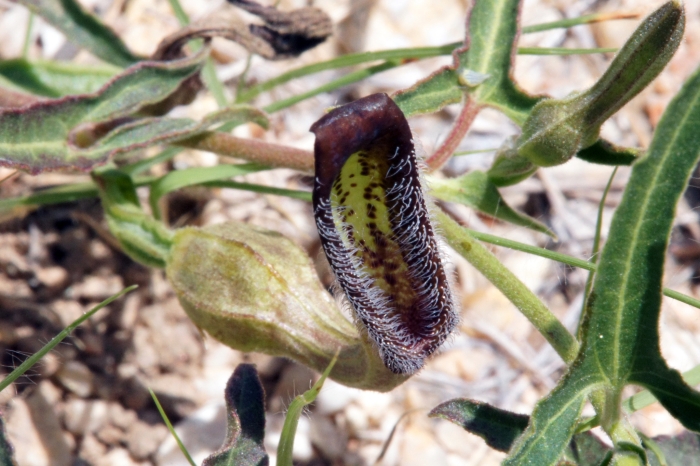Watson’s Dutchman’s Pipe
(Aristolochia watsonii)
Watson’s Dutchman’s Pipe (Aristolochia watsonii)
/
/

Saguaro National Park
CC BY 2.0
Image By:
Saguaro National Park
Recorded By:
Copyright:
CC BY 2.0
Copyright Notice:
Photo by: Saguaro National Park | License Type: CC BY 2.0 | License URL: https://creativecommons.org/licenses/by-sa/2.0/ | Uploader: SaguaroNPS | Publisher: Flickr |




















Estimated Native Range
Summary
Aristolochia watsonii, commonly known as Watson’s Dutchman’s Pipe, is a semi-deciduous perennial vine or herb. It is native to arid and semi-arid regions, often found in desert washes and riparian areas within the Southwestern United States and Northwest Mexico. This plant typically grows to a height of 2-3 feet and a width of 2 feet. Its growth habit includes scrambling stems that form a dense, tangled mat, particularly when growing on open ground. Watson’s Dutchman’s Pipe is cold-deciduous, shedding leaves in fall and winter, and may lose stems in freezing conditions. In full sun and drought, leaves can transition from green to a purple-brown hue. The flowers are peculiar and musky-smelling, resembling a rodent’s ear, with a coloration that transitions from green or burgundy-brown on the exterior to green speckled with burgundy-brown inside, and hairy on the opening ear rim. These flowers are not particularly showy due to their unusual appearance and brief lifespan of 1–2 days. The plant blooms from April to October, and its fruits are distinctive capsules with five vertical ribs, containing flat, black seeds in each of the five compartments.
Watson’s Dutchman’s Pipe is valued for its unique flowers and its ability to thrive in hot, dry climates with minimal water requirements. It is often used in xeriscaping, naturalistic plantings, and as a ground cover in appropriate regions. This plant prefers full sun exposure and well-drained soils, making it suitable for cultivation in arid gardens. It is also known to attract certain species of butterflies, which use it as a host plant for their larvae. However, gardeners should be aware that all parts of Aristolochia watsonii are toxic if ingested and the plant can be invasive in some areas outside its native range.CC BY-SA 4.0
Watson’s Dutchman’s Pipe is valued for its unique flowers and its ability to thrive in hot, dry climates with minimal water requirements. It is often used in xeriscaping, naturalistic plantings, and as a ground cover in appropriate regions. This plant prefers full sun exposure and well-drained soils, making it suitable for cultivation in arid gardens. It is also known to attract certain species of butterflies, which use it as a host plant for their larvae. However, gardeners should be aware that all parts of Aristolochia watsonii are toxic if ingested and the plant can be invasive in some areas outside its native range.CC BY-SA 4.0
Plant Description
- Plant Type: Vine
- Height: 2-2.5 feet
- Width: 1-1.5 feet
- Growth Rate: Moderate
- Flower Color: Green, Purple
- Flowering Season: Spring, Summer
- Leaf Retention: Semi-Deciduous
Growth Requirements
- Sun: Full Sun, Part Shade
- Water: Low
- Drainage: Fast
Common Uses
Bird Garden, Butterfly Garden, Hummingbird Garden, Low Maintenance
Natural Habitat
Native to arid and semi-arid regions, desert washes, and riparian areas within the Southwestern United States and Northwest Mexico
Other Names
Common Names: Indian Root, Southwestern Pipevine, Snakeroot
Scientific Names: , Aristolochia watsonii, Aristolochia porphyrophylla,
GBIF Accepted Name: Aristolochia watsonii Wooton & Standl.